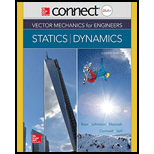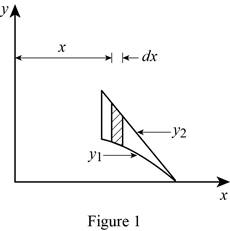
Concept explainers
The moment of inertia
Answer to Problem 9.20P
The moment of inertia
Explanation of Solution
Given information:
The equation of the upper segment is
The equation of the lower curve is
Calculation:
Draw the subject area with vertical differential strip element as in Figure (1).

Consider the curve equation as
Apply the boundary condition at
Condition 1:
At
Since
Condition 2:
At
Substitute
Consider the upper curve equation
Apply the boundary condition at
Condition 1:
At
Condition 2:
At
Subtract the equation (1) and (2).
Substitute
Rewrite the lower equation.
Substitute
Rewrite the upper equation.
Substitute
Calculate the area of the given figure (A) using the formula:
Substitute
Calculate the moment of inertia about y axis using the formula:
Substitute
Take
Differentiate the u equation with respect to x.
Take
Integrate the above equation with respect to x.
Consider the second term from the equation (3).
Integrate the above equation by UV method with respect to x.
Substitute
Since
Substitute
Calculate the radius of gyration
Substitute
Thus, the moment of inertia
Want to see more full solutions like this?
Chapter 9 Solutions
Connect 2 Semester Access Card for Vector Mechanics for Engineers: Statics and Dynamics
 Elements Of ElectromagneticsMechanical EngineeringISBN:9780190698614Author:Sadiku, Matthew N. O.Publisher:Oxford University Press
Elements Of ElectromagneticsMechanical EngineeringISBN:9780190698614Author:Sadiku, Matthew N. O.Publisher:Oxford University Press Mechanics of Materials (10th Edition)Mechanical EngineeringISBN:9780134319650Author:Russell C. HibbelerPublisher:PEARSON
Mechanics of Materials (10th Edition)Mechanical EngineeringISBN:9780134319650Author:Russell C. HibbelerPublisher:PEARSON Thermodynamics: An Engineering ApproachMechanical EngineeringISBN:9781259822674Author:Yunus A. Cengel Dr., Michael A. BolesPublisher:McGraw-Hill Education
Thermodynamics: An Engineering ApproachMechanical EngineeringISBN:9781259822674Author:Yunus A. Cengel Dr., Michael A. BolesPublisher:McGraw-Hill Education Control Systems EngineeringMechanical EngineeringISBN:9781118170519Author:Norman S. NisePublisher:WILEY
Control Systems EngineeringMechanical EngineeringISBN:9781118170519Author:Norman S. NisePublisher:WILEY Mechanics of Materials (MindTap Course List)Mechanical EngineeringISBN:9781337093347Author:Barry J. Goodno, James M. GerePublisher:Cengage Learning
Mechanics of Materials (MindTap Course List)Mechanical EngineeringISBN:9781337093347Author:Barry J. Goodno, James M. GerePublisher:Cengage Learning Engineering Mechanics: StaticsMechanical EngineeringISBN:9781118807330Author:James L. Meriam, L. G. Kraige, J. N. BoltonPublisher:WILEY
Engineering Mechanics: StaticsMechanical EngineeringISBN:9781118807330Author:James L. Meriam, L. G. Kraige, J. N. BoltonPublisher:WILEY





